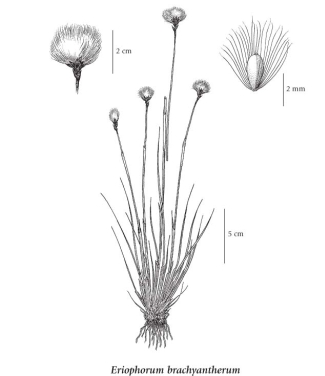Eriophorum brachyantherum Trautv. & C.A. Mey.
short-anthered cotton-grass (northland cottonsedge)
Cyperaceae (Sedge family)
Introduction to Vascular Plants
short-anthered cotton-grass (northland cottonsedge)
Cyperaceae (Sedge family)
Introduction to Vascular Plants
Map
Distribution of Eriophorum brachyantherum
Click here to view the full interactive map and legend
Species Information
General:
Perennial, densely tufted herb from fibrous roots; stems 30-60 cm tall.
Leaves:
Basal sheaths brownish, cross-wrinkled, persistent, not or only slightly expanded upwards, 2 of which with reduced or abortive blades generally borne above the basal cluster of leaves; blades about 1 mm wide or less, 1/2 as long to nearly as long as the stem, elongate, narrow, folded, the lower leaves with short blades less than 2 mm wide, the upper ones above the middle of the stem.
Flowers:
Spikes solitary, terminal, erect, egg-shaped and 1-2 cm long in flower, egg-shaped to nearly globe-shaped and 2-4 cm long in fruit; anthers short, up to about 1 mm long; involucral bracts lacking.
Fruits:
Scales of uniform colour, at least in the exposed portions, blackish-green, narrowly lanceolate, appressed to ascending, gradually tapering to slender tips, the midribs not reaching the tips, the sterile scales 10 to 15, below the fertile ones and appearing to gradually taper to the bases, or the sterile scales fewer and the spikes broader based, the lowermost scales 0.5-1 cm long, not reflexed; perianth bristles numerous, cream-coloured or yellow-tinged, surpassing the achenes; achenes brown, a little over 2 mm long, egg-shaped, sometimes narrowly so, somewhat sharp-pointed.
Illustration

If more than one illustration is available for a species (e.g., separate illustrations were provided for two subspecies) then links to the separate images will be provided below. Note that individual subspecies or varietal illustrations are not always available.
Illustration Source: The Illustrated Flora of British Columbia
Ecology
Ecological Framework for Eriophorum brachyantherum
The table below shows the species-specific information calculated from
original data (BEC database) provided by the BC Ministry of Forests and Range.
(Updated August, 2013)
The table below shows the species-specific information calculated from
original data (BEC database) provided by the BC Ministry of Forests and Range.
(Updated August, 2013)
| Site Information |
Value / Class |
||
|
Avg |
Min |
Max |
|
| Elevation
(metres) |
825 | 320 | 1464 |
| Slope
Gradient (%) |
0 | 0 | 8 |
|
Aspect (degrees) |
53 | 22 | 148 |
| Soil
Moisture Regime (SMR) [0 - very xeric; 4 - mesic; 8 - hydric] |
6 | 6 | 8 |
| Modal
Nutrient Regime
Class |
A | ||
| #
of field plots species was recorded in: |
37 | ||
| Modal
BEC Zone Class |
BWBS | ||
|
All BEC Zones (# of stations/zone) species was recorded in |
BWBS(12), ESSF(4), ICH(4), SBPS(3), SBS(10) | ||
|
Source:
Klinkenberg 2013
|
|||